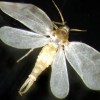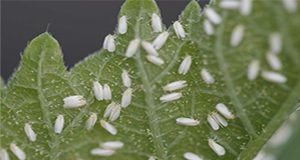Whiteflies are a common pest of many ornamental plants throughout Florida and the world. There are more than 1,500 species worldwide and over 75 reported in Florida. Although infestation does not always require treatment, it is important to be able to identify and monitor for these pests for effective integrated pest management. This 8-page fact sheet written by Eileen A. Buss, Catharine Mannion, Lance Osborne, and Adam Dale and published by the Entomology and Nematology Department describes whitefly species, their identification and biology, the damage they cause, and best management practices to control them and still maintain healthy populations of natural enemies and other beneficial insects.
http://edis.ifas.ufl.edu/mg254
Tag: Landscape Whitefly Pests
Whitefly (Bemisia tabaci) Management Program for Ornamental Plants
Silverleaf whitefly is one of the most notorious invasive arthropods worldwide. It feeds on more than 900 plant species and vectors over 100 plant-damaging viruses. This 10-page fact sheet written by Vivek Kumar, Cristi Palmer, Cindy L. McKenzie, and Lance Osborne and published by the Department of Entomology and Nematology provides management recommendations, strategies for detection and scouting, and advice about control measures for this pernicious pest.
http://edis.ifas.ufl.edu/in1171
Rugose spiraling whitefly Aleurodicus rugioperculatus Martin (Hemiptera: Aleyrodidae)
 A new addition on the list of whitefly species found in Florida, Aleurodicus rugioperculatus Martin, was originally called the gumbo limbo spiraling whitefly, but is now named the rugose spiraling whitefly. Being a fairly new species to science – identified less than a decade ago, not much information is available about this pest. It is an introduced pest, endemic to Central America, and was reported for the first time in Florida from Miami-Dade County in 2009. Since then it has become an escalating problem for homeowners, landscapers, businesses, and governmental officials throughout the southern coastal counties of Florida. Feeding by this pest not only causes stress to its host plant, but the excessive production of wax and honeydew creates an enormous nuisance in infested areas. The presence of honeydew results in the growth of fungi called sooty mold, which then turns everything in the vicinity covered with honeydew black with mold. This 5-page fact sheet was written by Vivek Kumar, Cindy L. McKenzie, Catharine Mannion, Ian Stocks, Trevor Smith, and Lance S. Osborne, and published by the UF Department of Entomology and Nematology, October 2013.
A new addition on the list of whitefly species found in Florida, Aleurodicus rugioperculatus Martin, was originally called the gumbo limbo spiraling whitefly, but is now named the rugose spiraling whitefly. Being a fairly new species to science – identified less than a decade ago, not much information is available about this pest. It is an introduced pest, endemic to Central America, and was reported for the first time in Florida from Miami-Dade County in 2009. Since then it has become an escalating problem for homeowners, landscapers, businesses, and governmental officials throughout the southern coastal counties of Florida. Feeding by this pest not only causes stress to its host plant, but the excessive production of wax and honeydew creates an enormous nuisance in infested areas. The presence of honeydew results in the growth of fungi called sooty mold, which then turns everything in the vicinity covered with honeydew black with mold. This 5-page fact sheet was written by Vivek Kumar, Cindy L. McKenzie, Catharine Mannion, Ian Stocks, Trevor Smith, and Lance S. Osborne, and published by the UF Department of Entomology and Nematology, October 2013.
http://edis.ifas.ufl.edu/in1015
Natural Enemies of Rugose Spiraling Whitefly, Aleurodicus rugioperculatus Martin (Insecta: Hemiptera: Aleyrodidae) in the South Florida Landscape
 Rugose spiraling whitefly was first observed in south Florida in 2009. It has been found in 17 counties in south and central Florida. This whitefly has been reported on more than 60 plant species, which include gumbo limbo, coconut, black olive, avocado, Calophyllum spp., and giant white bird of paradise. This 6-page fact sheet describes the predators and parasitoids found feeding on this whitefly in the south Florida landscape. Written by Siavash Taravati, Catharine Mannion and Holly Glenn, and published by the UF Department of Entomology and Nematology, August 2013.
Rugose spiraling whitefly was first observed in south Florida in 2009. It has been found in 17 counties in south and central Florida. This whitefly has been reported on more than 60 plant species, which include gumbo limbo, coconut, black olive, avocado, Calophyllum spp., and giant white bird of paradise. This 6-page fact sheet describes the predators and parasitoids found feeding on this whitefly in the south Florida landscape. Written by Siavash Taravati, Catharine Mannion and Holly Glenn, and published by the UF Department of Entomology and Nematology, August 2013.
http://edis.ifas.ufl.edu/in1004
Whiteflies on Landscape Ornamentals (ENY317/MG254)
 Whiteflies are common pests on many ornamental plants. Some of the most economically important species in Florida are the silverleaf whitefly, fig or ficus whitefly, citrus whitefly, and the rugose spiraling whitefly. The most frequently attacked plants include allamanda, avocado, chinaberry, citrus, fig, fringe tree, gardenia, gumbo limbo, ligustrum, mango, various palms, persimmon, viburnum, and many annuals. This 4-page fact sheet was written by E. A. Buss, and published by the UF Department of Entomology and Nematology, March 2013.
Whiteflies are common pests on many ornamental plants. Some of the most economically important species in Florida are the silverleaf whitefly, fig or ficus whitefly, citrus whitefly, and the rugose spiraling whitefly. The most frequently attacked plants include allamanda, avocado, chinaberry, citrus, fig, fringe tree, gardenia, gumbo limbo, ligustrum, mango, various palms, persimmon, viburnum, and many annuals. This 4-page fact sheet was written by E. A. Buss, and published by the UF Department of Entomology and Nematology, March 2013.
http://edis.ifas.ufl.edu/mg254

